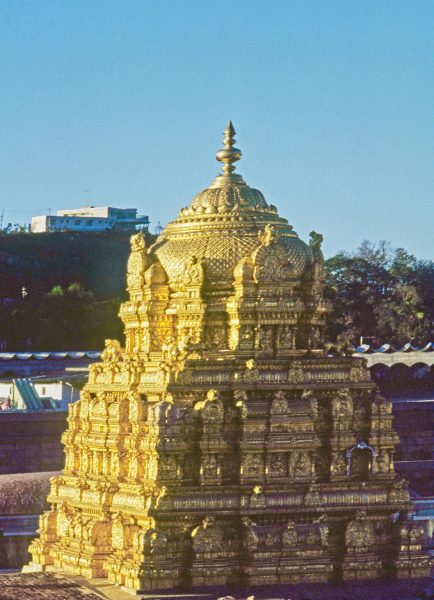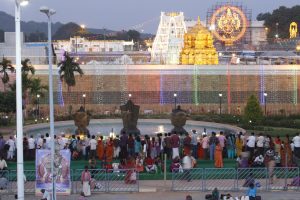
Tirupati temple to remain open during gold-plating project
Temple board plans to start project in March despite concerns about historic structure's safety; there are also questions on how truly the plan adheres to Agama practices

The Tirumala temple in Tirupati is set for a major reconstruction project, with the temple authorities planning an ambitious gold-plating initiative for its Ananda Nilayam, the three-storied vimana (dome or gopuram) atop the sanctum sanctorum, after 65 years.
While devotees are visibly perturbed, wondering if they can have an uninterrupted darshan of Lord Balaji during the 6-8 months that the project is likely to take, experts are concerned about other aspects of it. There is deep worry about the safety of the historic Ananda Nilayam (which translates to ‘Abode of Bliss’) during the gold-plating exercise.
Watch: Here is what Tirupati devotees can expect this year amid gold-plating work
Yet, the Tirumala Tirupati Devasthanams (TTD) trust board is going ahead with the programme. The work is scheduled to commence on March 1, 2023. Discussions about the project have been going on for decades, but it could not be commissioned as the project was incessantly embroiled in controversies.
However, on November 30, 2022, the TTD trust board resolved to take up the gold-plating work of the vimana gopuram, which houses the presiding deity of Lord Venkateswara. It is a 37.8-ft three-storied structure and its square base is 27.4 feet in perimeter. According to the TTD chairman YV Subbareddy, the work will be completed in six months.
The proposal to gold-plate the gopuram has always led to a clash of opinions. While the TTD board is enthusiastic about turning the abode of ‘Lord of Seven Hills’ into a ‘golden temple’, the proposal is met with fierce opposition from historians and archaeologists.
Earlier gold-plating efforts
The temple is protected by prakaras (walls). In 2005, there was a proposal to cover the vimana prakaram i.e., the wall of the sanctum sanctorum, also called Ananda Nilaya Prakaram, with gold. The proposal to fix gold-copper sheets on the wall by bolts was rejected by Agama advisers contending that it goes against the sastras.
Also read: Tirupati sanctum sanctorum to remain shut for 6-8 months in 2023 as dome gets new plating
Again, on September 20, 2009, the TTD board passed a resolution to launch a programme called ‘Ananda Nilaya Ananta Swarnamaya Project’ to gold-lace the Ananda Nilaya Prakaram. However, the existence of 740 inscriptions on the wall became a bone of contention. The project landed in controversy.

Those in favour of preserving the inscription in their original form approached the High Court, which stalled the project in November 2010, stating that as the walls contain inscriptions of immense religious value, they cannot be tampered with, be it gold-plating or any other embellishment.
On November 30, 2022, the board appointed by YS Jagan Mohan Reddy’s government proposed to gold-plate the Ananda Nilaya Vimana Gopuram from March 2023. Though the fate of the proposal cannot be anticipated, the TTD is getting its act together to complete it in 2023 itself.
Establishment of Balalayam
According to TTD chief priest Venugopala Deekshitulu, the process of gold-plating will commence once a Balalayam (where the divine power is ‘transferred’ to a wooden idol of the deity) is set up in the temple precincts. This takes place whenever the sanctum sanctorum needs repairs, which is usually done once in 12 years.
In a way, the Balayalam is a temporary replacement of the sanctum sanctorum — all the daily rituals of the temple would be performed in this temporary model temple, Deekshitulu told The Federal.
“The need for the erection of a Balalayam arises when repairs or other works are to be undertaken in the sanctum sanctorum. The repair works cannot be taken when the Moola Murthy (presiding deity) remains there. In Hindu temples, the Moola Murthy is said to be the storehouse of divine power. So, the divine power is to be transferred to another idol before the workers are given access to the temple,” he explained.
Also read: In Telugu states, precious Buddhist archaeological sites are in shambles
“In some temples, the statue of the presiding deity is taken out of the sanctum sanctorum and preserved in grains for so long as the works are undertaken. In the case of Tirumala, the Moola Murthy cannot be shifted as the Lord is swayambhu (self-manifested). So, its divine power needs to be transferred to a replica of the deity which is carved out of daru (wood).
“The transferring of divine power from Moola Murthy to the wooden idol is an elaborate process. The transfer of divine power takes place through a process called Avahana or Kalavahana. Later, this wooden statue with divine power is installed in the Balalayam and offered all daily sevas. Only when the Balalayam is set up can the workers enter the temple to take up repairs or other developmental works,” said Venugopal Deekshititu.
He added that only after the Kalavahana is completed can the workers enter the sanctum sanctorum or climb the gopuram for gold-plating.
Where ‘Arjita Sevas’ will be held
Further, Deekshitulu said: “During the six-month period, the devotees can continue to have darshan of the Moola Murti. However, all the Arjita Sevas (rituals for the deity) will be performed in ekantham (out of public sight) alone, from morning Suprabatam to Ekantha Seva in the night, as per Agama traditions. The Arjita Sevas like Kalyanotsvam and Arjita Brahmotsavam will be performed for the utsava idols of Sri Malayappa Swami (Lord Balaji) and his consorts Sridevi and Sri Bhudevi,” he said. Utsava murtis are typically metal versions of the main deity, on which various rituals are performed.
Recalling the gold-plating works in 1957-58 and Balalaya ceremony in 2018, he said at that time, the Srivari Moola Murti Darshan (darshan of the main deity) and arjita sevas for utsava idols were performed without interruption.
Also read: Tirupati temple discloses wealth; richer than Wipro, Nestle, ONGC
In 1957-58, gold lacing work had been completed in nine months and the arrangements and rituals followed then would be replicated now. Dismissing concerns that the gold-plating would damage the structure, Deekshitulu said it was an opportunity to identify the gaps in the gopuram structure.
Stating that the gold-plating of the Sri Govindaraja Swamy temple at Tirupati (the town on the plains) was also taken up by constructing a Balalayam, the chief priest said that with the Balalayam serving as a model temple with all daily rituals, there was no need to close the temple for repairs.
With regard to the Tirumala temple, the head priest said, the media reports that it would be closed during the period of gold-plating were wrong.
“The gopuram is not constructed with stones. It is made of stucco. While fixing the new gold plates, the gaps in the stucco structure can be filled up. This would in fact strengthen the structure,” he observed.
Also read: Tirupati temle owns assets worth ₹85,705 crore, reveals managing board
Inside the sanctum sanctorum, a shelter would be erected to cover the presiding deity to prevent the roof plaster from falling on it, he added.
Moreover, there are no specific pujas for gold-plating. The workers can climb the tower and commence their work once the Balalayam rituals are performed, he further said.
An activist’s concerns
BKSR Ayyanagar, an activist who has been fighting for autonomy for Hindu temples, wonders how Arjita Sevas can be performed to the Moola Murthy when the workers are at work on the temple gopuram, and how the authorities would allow thousands of devotees to have darshan of Moola Murthy when the project is ongoing.
“When the divine power of the Lord is transferred to kalasam and daru Idol and Balalayam comes into existence, the place ceases to be a place of worship. How would you offer sevas and allow devotees to throng the sanctum sanctorum?” he asked in a letter written to the TTD.
Ayyanagar objected to the temple board taking up the gold-plating work without obtaining opinions from archaeologists, either from the state or the Archaeological Survey of India, on the strength of the gopuram, an ancient heritage structure.
Absence of archaeological opinion
“The Andhra Pradesh High Court clearly stated that the structure was historical and deserves ‘the equi respect treatment and consequent protection’. So, it is the responsibility of TTD to take the views of the archaeological experts on the strength of the structure before taking up gold-plating, which is expected to add more weight and requires drilling holes that can damage the structure,” Ayyanagar said.
“And, the work requires drilling of holes, which is bound to damage the structure. But surprisingly, TTD is silent on obtaining reports from archaeologists either from the state or the ASI,” he added.
Stating that TTD owes an explanation to the people in the absence of archaeological opinion, he said he would challenge the TTD decision in court if proper clarification is not forthcoming.
An archaeologist who worked both in Andhra Pradesh and Telangana also felt that gold-plating would pose a threat to the ancient structure. Talking to The Federal on condition of anonymity, he said gold-plating is not mentioned in the Agamas.
“The gopuram is supposed to be constructed with stone, brick and lime as per the Agamas. Gold-plating is not mentioned anywhere,” he said, and added that the temple wealth should not jeopardise a structure of immense historical and heritage value.
“The Tirumala sanctum sanctorum, along with its gopuram, have been carved out with brick and lime with superb workmanship. With the gold-plating, the original workmanship and aesthetics of the structure go out of view and the public would have no chance to appreciate the ancient historicity of the structure. One needs to drill a number of holes in the structure to fix the gold plates. It is bound to weaken the structure to that extent,” he opined.

